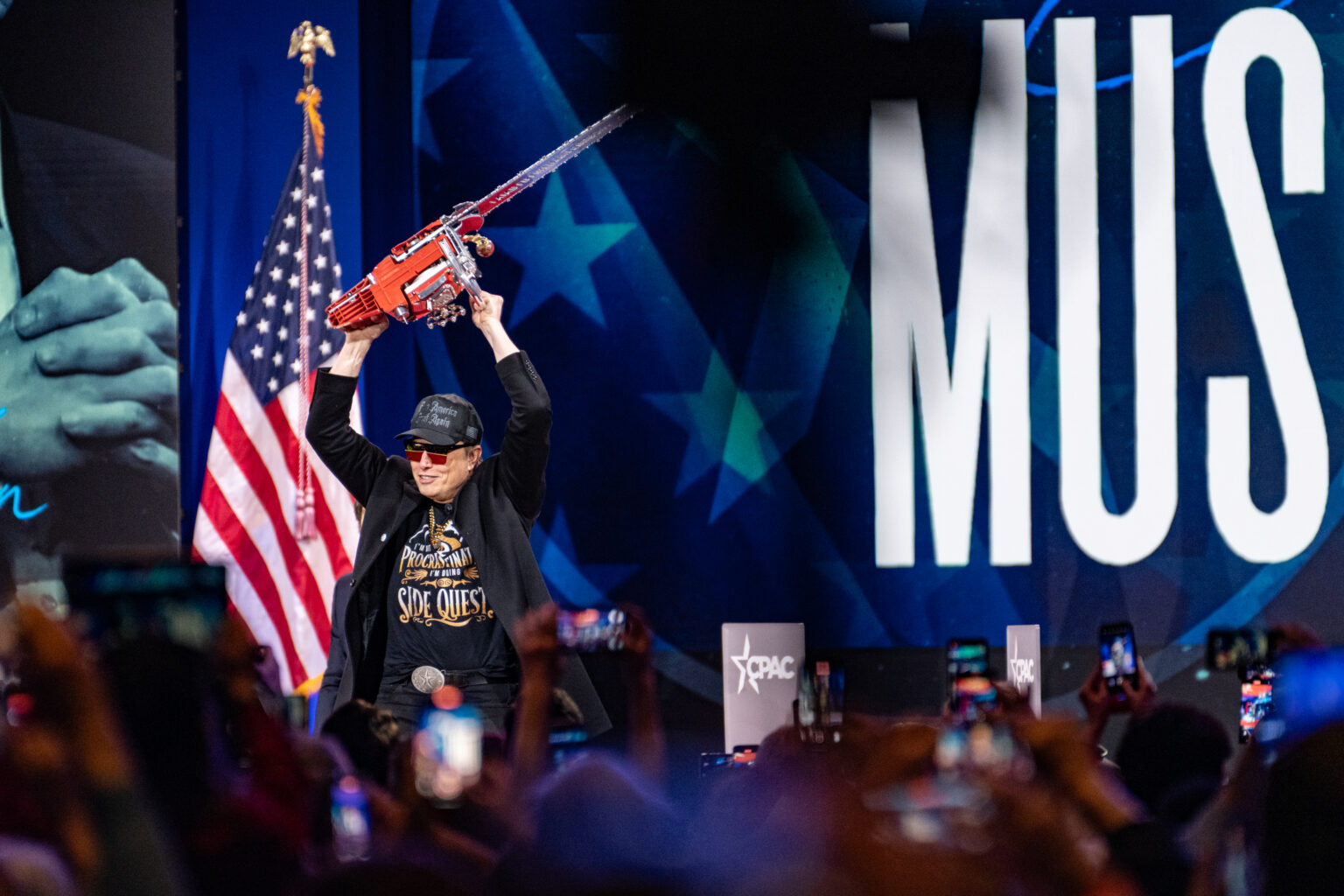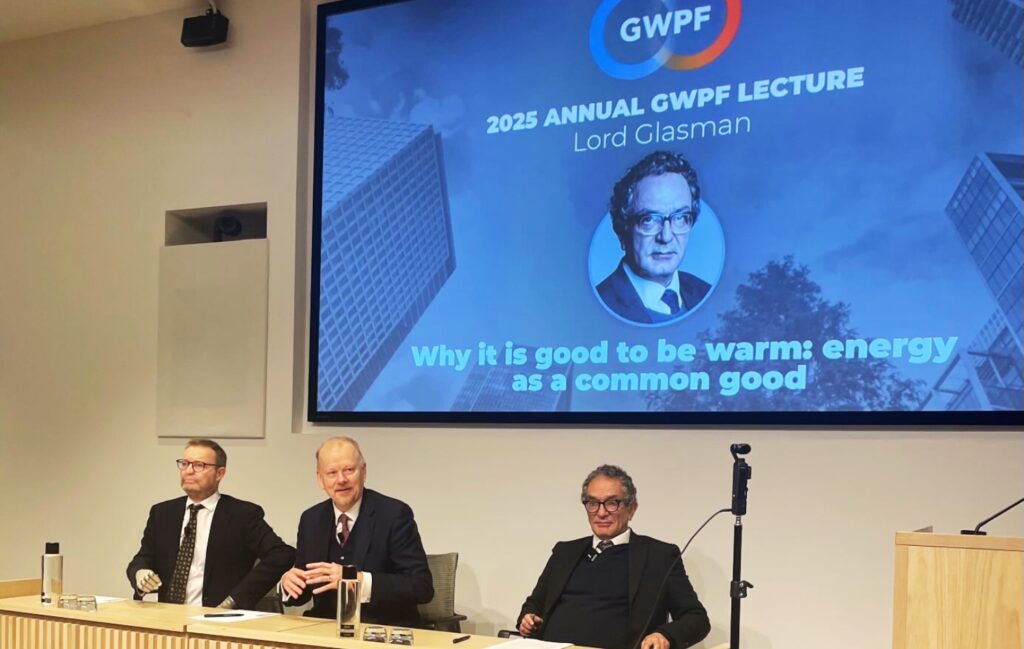Elon Musk’s time in the federal government is entering a new phase, the White House has confirmed. But the work he began at the Department of Government Efficiency (DOGE), the hastily renamed agency he’s used to make legally questionable changes within the federal government, will clearly continue.
“DOGE is a way of life. Like Buddhism,” he said, in an April 30 press conference. “Is Buddha needed for Buddhism? Was it not stronger after he passed away?”
It was typical Elon, tactless and grandiose. But it was also a surprising acknowledgment: Musk had never been the prime mover. He was merely someone who embodied a larger ideal. Someone who vibrantly channeled ideas that predated his arrival on the scene, and would go on existing long after his exit.
We know those ideas by another name: Project 2025 — the notorious, Heritage Foundation-led effort to dismantle the government by firing federal workers en masse, to secure the borders via drastic steps, and to “restore the family” and instill Christian Nationalist values by, for instance, targeting federal diversity, equity, and inclusion measures.
A DeSmog analysis found that DOGE’s explosive tactics under Musk represented the culmination of a years-long strategy to remake American governance, one developed by a small, influential network of conservative and far-right groups whose influence on Trump may tilt the U.S. toward autocracy. While ranging in focus, these groups generally mix an authoritarian brand of Christian Nationalist politics with free-market libertarianism — an ideology that tends to favor restrictive laws for citizens and leniency for corporations. Many also cast doubt on the dangers of climate change and work to undermine the federal government’s ability to respond to rapid warming. And Musk — contrary to his reputation as an ungovernable outsider with his own big ideas — was carrying out their vision to a T.
But it was more than that: Musk’s arrival on the scene helped to launder the reputation of an enormously unpopular playbook, putting techno-utopian lipstick on the Project 2025 pig. By September 2024, Project 2025 was polling at just 4 percent approval, according to NBC News; shared hatred for the Heritage Foundation-backed initiative seemed to be the one thing most Americans agreed on. Musk fundamentally changed the perception of what was essentially the same vision, implemented by the same people. It didn’t take long for the media coverage and public outcry to shift away from Project 2025 and focus on one person above all: Elon Musk. America followed the shiny object.
Subscribe to our newsletter
Stay up to date with DeSmog news and alerts
The obsession with Musk made sense. As the eccentric CEO of multiple high-profile companies and the world’s richest man, he’s a bonafide celebrity who’s long been a source of public fascination. Musk also seems to love the spotlight, frequently courting it with headline-grabbing antics, orchestrated publicity stunts, and through-the-night postings.
In the first weeks and months of the second Trump administration, his every move seemed designed to get people talking. Named in honor of a memed-out cryptocurrency Musk’s hyped throughout the years, DOGE’s extremely online branding told us: look at me. It’s government chaos custom-built to go viral, with Musk as the main character of each late-breaking story. And as the spotlight on him brightened, the focus on Project 2025 and the groups behind it dwindled.
Yet, Musk’s outsized personality and outrageous behavior have helped to obscure a starker truth: He was never acting alone. His links to key Project 2025 personnel go back years. And those relationships turned out to be central to aligning DOGE’s work with the broader vision outlined in the Project 2025 “Mandate for Leadership,” the 900-page policy proposal published by the Heritage Foundation with assistance from dozens of other conservative groups.
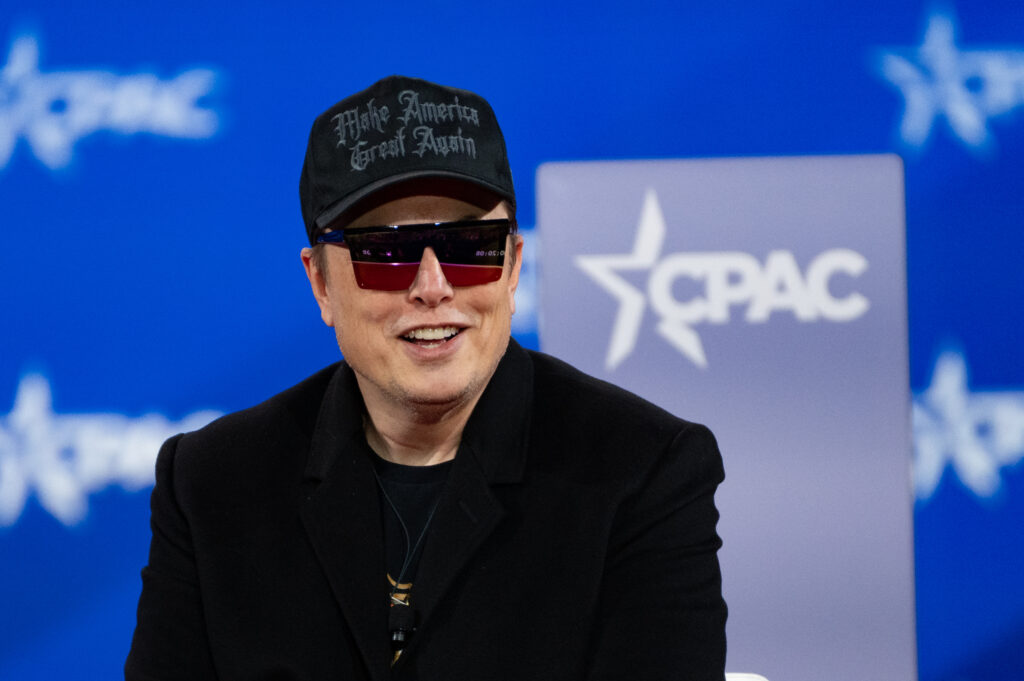
That’s not to say that Musk, Trump, and the groups behind Project 2025 have always been in lockstep. In recent weeks, especially, tensions between Musk and the administration have spilled out into the open. But the Mars-obsessed futurist and the groups behind Project 2025 continue to share a critical strategic objective: an American government with hobbled regulatory power. And that’s resulted in a potent new marriage of convenience.
“Silicon Valley, you know — the Peter Thiels, the Elon Musks — have an absolute confidence in their own ability to change the system through application of a kind of a top-down authoritarian expertise,” said Darren Dochuk, a University of Notre Dame history professor and expert on the coordination between evangelical faith leaders and the oil industry. Both factions, he said, want “to do away with a bureaucratic apparatus, a legacy of the liberal state that, in their eyes, is not just inefficient, but does damage to one’s ability to dream a new American future.”
Candidate Trump claimed to know nothing about this deeply conservative, and publicly toxic, policy roadmap. But the result is undeniable: his administration is racing to enact Project 2025’s vision of America, with help from the very people who wrote the plan. And Elon Musk was central to it all, supercharging their agenda while giving Trump himself distance from the enormously unpopular playbook — a combination of linchpin and fall guy.
Elon’s $43 Million Link to Project 2025’s Architects
Few people saw it coming at the time, but by mid-2022 the stage for DOGE’s mass firings had already been set. On April 4 of that year, a financial filing revealed Musk was Twitter’s biggest shareholder; quietly, he’d purchased about nine percent of its public stock. Twitter’s share price surged at the news, but Musk wasn’t going to stop there. On April 14, he announced he wanted to buy the platform outright, and take it private for a whopping $43 billion. It would turn out to be one of the most consequential developments in the 2024 election, still a couple years away.
Just a week later, on April 21, Trump addressed members of the Heritage Foundation at his Mar-a-Lago resort. Project 2025 had not yet been introduced publicly, and its sprawling “Mandate for Leadership” document hadn’t been written yet. But one thing was clear: Trump emerged from the event feeling that Heritage would play a major role in his next administration, should he be re-elected. “They’re going to lay the groundwork and detail plans for exactly what our movement will do,” he said.
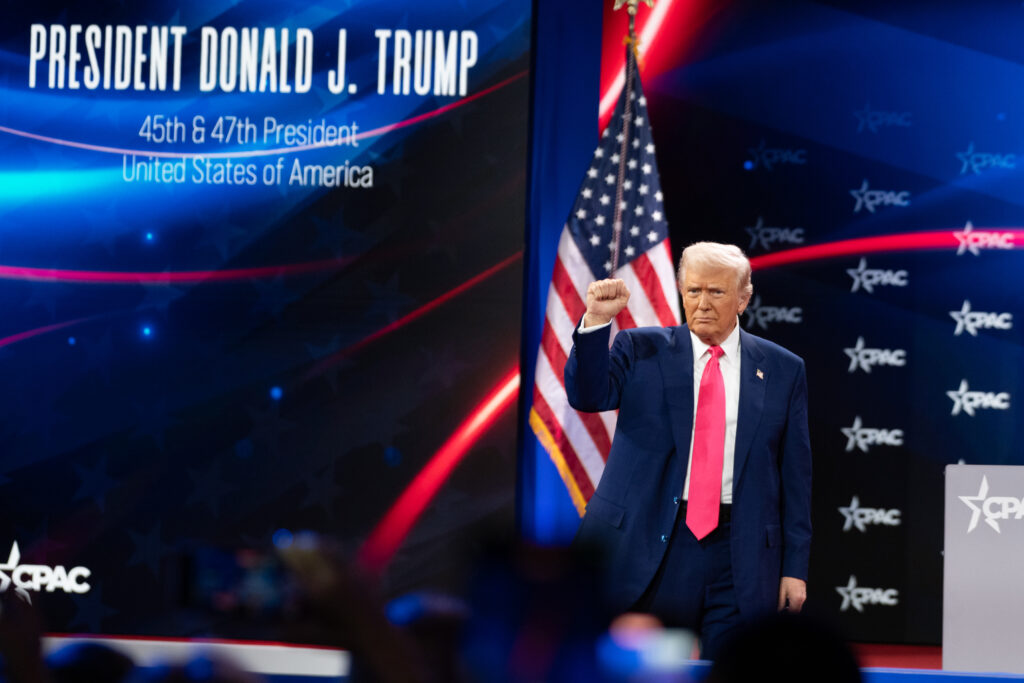
In the following weeks and months, those three circles of influence — Trump, Musk, and the Heritage Foundation — increasingly began to converge.
On April 28, a week after his Heritage event, Trump hosted a fundraiser for the Center for Renewing America (CRA) at Mar-a-Lago. It was a new nonprofit founded by Russell Vought, who had been budget director during Trump’s first term. At CRA, Vought, a former Heritage staffer who identifies as a Christian Nationalist, had reportedly helped state legislators craft bills that would outlaw teaching about racial justice or other “divisive concepts” in schools. Vought’s organization also promoted fossil fuel interests, complaining on its website that Biden’s pivot away from oil, gas, and coal was “crippling America.” But his main obsession was with slashing the size of the federal government, an effort that had been foiled repeatedly by career officials during his time in office.
“I can’t tell you how many times I would get the question, ‘well, that’s not allowed,’” he told NPR, in 2023.
At the April 2022 fundraiser, Trump gave remarks with a Center for Renewing America logo shining brightly on-screen beside him. The following day, CRA’s Twitter account posted photos of Vought and Trump shaking hands in front of the podium, backdropped by Mar-a-Lago’s palm trees and porticos. “We are building a first rate America First organization and are committed to strengthening the movement that [Trump] built,” CRA tweeted.
At the time, the Center for Renewing America was formally housed within America First Legal, a nonprofit founded by former Trump advisor Stephen Miller. (Today, Miller is serving as Trump’s deputy chief of staff.) Both groups were launched by the Conservative Partnership Institute, a D.C. think tank that helped to kickstart at least five other Project 2025 advisory groups, and also signed on to the initiative itself. Together, Miller, Vought, and their respective organizations would reportedly go on to be key architects of the “Mandate for Leadership,” Project 2025’s guiding document. And in the lead-up to that effort’s public unveiling, they would shortly get a massive boost from an unlikely source: Elon Musk.
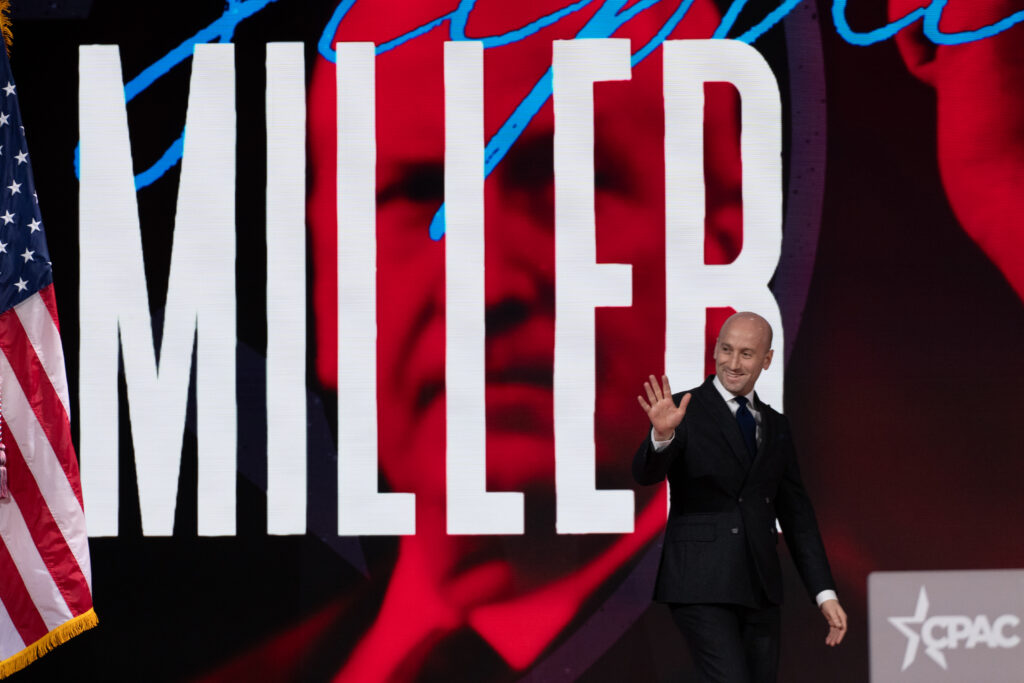
In June 2022, Miller’s America First Legal — with Vought serving as the board’s treasurer — started Citizens for Sanity, a new 501(c)(4) advocacy arm staffed by former Trump administration officials. Their stated mission: to “defeat ‘wokeism.’” That fall, across American cities, the group ran billboards with fake slogans intended to mock the ultra-progressive left. “Mother Nature is RACIST. End environmental racism now,” one sign read. Another: “Demand transportation equity for pansexuals NOW.” To commuters passing through the well-trafficked byways, it was unclear if the signs were parody or a reflection of some constituency’s genuine ideals. What was also unclear, by design, was that Musk was the campaign’s central funder.
From there, the group began to release a flood of violent, inflammatory, and misleading video ads that accused Democrats of raising the price of energy, “helping killers kill again” with its stance on immigration, and conducting a “war on biology” for supporting policies that would help provide gender-affirming care to transgender people.
It wasn’t until October 2024, just a month before the election, that the Wall Street Journal revealed Musk’s connection. He’d secretly funneled at least $43 million to Citizens for Sanity through a nonprofit called Building America’s Future. Musk’s involvement was intentionally made obscure, according to the Journal, and nonprofit employees involved in the transfer often reportedly coordinated using the encrypted messaging app Signal. The Journal article did not mention that Vought, Miller, and America First Legal would, from there, go on to play a key role in creating the “Mandate for Leadership.”
By October 2022, Citizens for Sanity was running TV ads that aired during the World Series — messages seen by millions, though the links between Musk, Trump, and Vought had not yet become clear. But connections slowly began to emerge. In December, the Heritage Foundation, with the support of Miller’s America First Legal, Vought’s Center for Renewing America, and other organizations, formally launched a website devoted to an ambitious new initiative: Project 2025.
What Is Project 2025?
On the surface, Project 2025 was never about Trump. In order to maintain their nonprofit status, 501(c)(3) organizations like the Heritage Foundation aren’t allowed to stump for any specific candidate. So the effort’s central document, published as part of Heritage’s long-running “Mandate for Leadership” series of policy papers dating back to the Reagan era, was ostensibly candidate-agnostic. It was simply a detailed, 900-page guide for how “the next conservative president” should approach his first 180 days.
And yet, as is now widely understood, the paper was authored by members of Trump’s inner circle. Paul Dans, a Heritage staffer who’d been Trump’s chief of staff at the Office of Personnel Management, was directing the project. And Steven Groves, who helped represent the White House in the Mueller investigation as assistant special counsel, co-edited the blueprint.
Behind the scenes, though, Vought and Miller were reportedly central to the document’s genesis and overall conception. A person close to the effort later told The New Yorker that Miller and Vought, as well as representatives from a third group launched by the Conservative Partnership Institute, American Moment, were the “key nodes” of the project. “[Heritage Foundation president Kevin] Roberts was paying Center for Renewing America, American Moment, and America First Legal to do parts of the project,” the person said.
So fresh off Musk’s massive donation, Miller and Vought were reportedly working to craft the now-notorious plan for the Trump administration’s first six months. In April 2023, when Heritage published Project 2025’s flagship document, it outlined instructions for “how to fire supposedly ‘un-fireable’ federal bureaucrats; how to shutter wasteful and corrupt bureaus and offices; how to muzzle woke propaganda at every level of government; how to restore the American people’s constitutional authority over the Administrative State; and how to save untold taxpayer dollars in the process.”
In other words, its stated goals were virtually indistinguishable from what Musk more recently pledged to do, and in many cases had been attempting, with DOGE — to carry out mass firings, and engage in culture war antics, in the name, at least, of cutting “waste.”
The “Mandate for Leadership” was a radical document in tone and substance, combining calls to, say, eliminate the entire Department of Education with even fringier — and Vought-endorsed — ideas like a national ban on pornography. It reserved an especially intense brand of vitriol for Biden-era climate policy, which, Vought wrote, deserved a “whole-of-government unwinding.” That assertion came in Vought’s Project 2025 chapter on investing the office of the president “enormous power” to dictate governance, where he also argued that the Biden administration’s “climate fanaticism” was part of a “woke agenda” that “should be reversed and scrubbed from all policy manuals, guidance documents, and agendas.”
Elsewhere in the Project 2025 document, co-authors called for purging the U.S. Environmental Protection Agency’s (EPA) “costly, job-killing regulations” as well as dismantling and moving to privatize parts of the National Oceanic and Atmospheric Administration, a critical source of data on weather and climate — exactly as DOGE and Vought’s budget office would later attempt to do.
Project 2025 Denial
Musk didn’t publicly announce his intent to form a “government efficiency commission” until August 2024. The name DOGE came from a user on X, according to the Times.
As election coverage heated up, Project 2025 increasingly became a political liability for Trump. Hatred for the Heritage-backed effort, it sometimes seemed, was the one thing Americans could agree on: It had just a four percent approval rating, an NBC poll found in late September, despite its broad name recognition.
During both the campaign and now, the Trump team has denied any involvement with Project 2025. “As President Trump has said many times, he had nothing to do with Project 2025,” White House spokesperson Harrison Fields told DeSmog.
On June 12, 2024, ABC News reported that Miller had requested that Heritage remove America First Legal, the organization he founded and directed, from Project 2025’s advisory board.
“I have zero involvement with Project 2025. Zero. None,” Miller told ABC News. “I have no involvement with the project whatsoever.”
It was an absurd denial: At the time, America First Legal was still listed on Project 2025’s website as an advisory group. Its vice president, Gene Hamilton, wrote the chapter on the Department of Justice. (He called it a “bloated bureaucracy” that must be revamped and made “more closely aligned with the President’s policy agenda,” including the FBI.) Hamilton thanked the entire staff of America First Legal in his acknowledgments, saying they deserved “special mention” for their efforts, and three other staffers from the organization are listed as contributors in the “Mandate.”
But by June 13, a day after the ABC story, America First Legal had been removed from the list of advisory groups on Project 2025’s website.
Between July 7 and July 13, search interest in the term “Project 2025” hit its all-time high, according to data from Google Trends. The coverage was relentless: major news outlets, including The New York Times, The Washington Post, the Associated Press, and NPR, covered the effort that week, with many stories pointing to Trump’s attempts to distance himself from the project, despite close ties.
But two things happened that forever changed the narrative of the election: On July 13, President Trump survived an assassination attempt in Butler, Pennsylvania. And then, within hours, Musk formally endorsed him.
Yes, Project 2025 continued to be a helpful talking point for Democrats. But Musk proved to be a far less controversial platform for what was essentially the same idea. In October, the co-chair of Trump’s transition team, billionaire Cantor Fitzgerald CEO Howard Lutnick said the Heritage Foundation had become politically “radioactive” thanks to Project 2025. Just two weeks later, he posted a picture of himself with Musk to X.
“Welcome to DOGE. We will rip the waste out of our $6.5 Trillion budget. Our goal: Balance the Budget of the USA. We must elect Donald Trump President,” he wrote. Musk’s mad scientist persona helped to launder the same slash-and-burn idea that Lutnick felt the transition team couldn’t otherwise touch. (Lutnick now serves as Trump’s Secretary of Commerce.)
The election had barely been decided for a week before Musk and Project 2025 began to fully, openly intersect. He “hit it off” with Vought — whose America First Legal had directly controlled the Citizens for Sanity group Musk had secretly funded back in 2022 — in tete-a-tetes at Mar-a-Lago, insiders told The New York Times. In a series of “closely held” meetings immediately after the election, Musk “absorbed as much as he could about the budget process and the bureaucracy that he intended to dismantle from Mr. Vought,” as well as Stephen Miller, the Times wrote.
Due to Project 2025’s toxic public perception, Vought was not reportedly under consideration to resume his post at OMB, the Times reported. But only a little more than a week after he won Musk’s enthusiasm, Trump had announced that he intended to nominate Vought to the position. Musk apparently liked that Vought was willing to “take the most extreme action possible,” according to the Times.
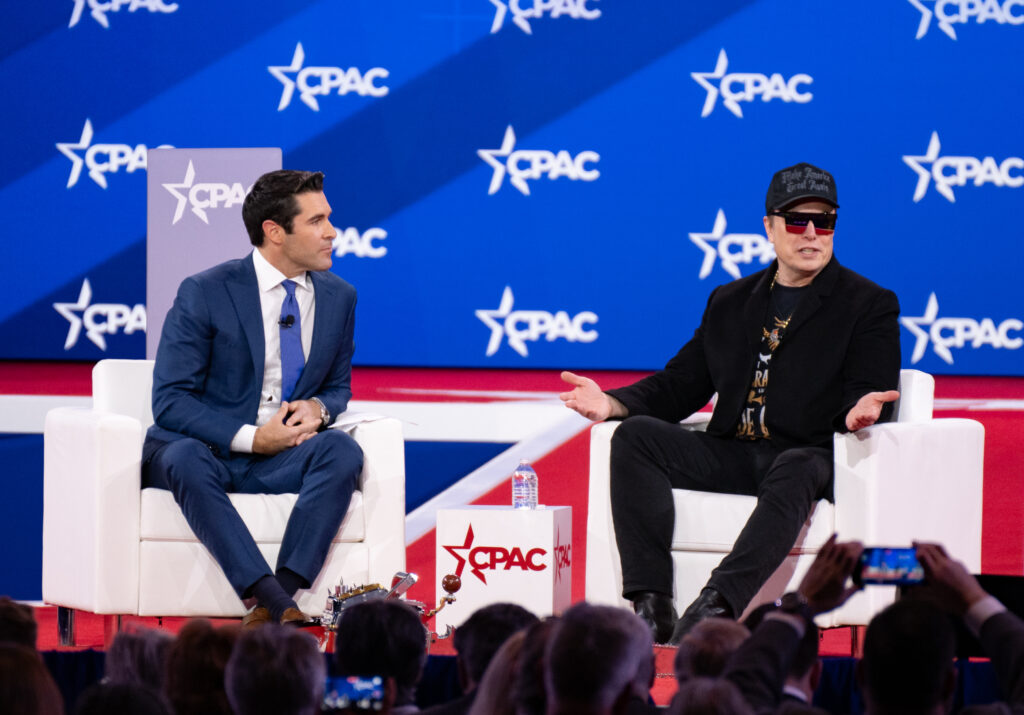
“The Department of Government Efficiency will . . . partner with the White House and Office of Management & Budget to drive large scale structural reform, and create an entrepreneurial approach to Government never seen before,” Trump wrote, in a November 12 statement from the transition team — making Musk and Vought’s partnership official.
Yet, press coverage still tended to report on DOGE like a wholly separate effort from what the Heritage Foundation and its allies had proposed. And public anger and outcry about the cuts focused on Musk more often than Vought and the other Project 2025 allies Trump had disavowed. But that framing failed to capture the reality of the moment. As Trump took power, it could be hard to tell where Vought’s OMB ended and Musk’s DOGE began. The two teams have closely collaborated on a range of slash-and-burn efforts.
Former Trump administration officials described the dynamic to Politico in a March 2025 piece: Musk would use his DOGE army to look for spending to cut, while publicizing the efforts on X. Then Vought’s OMB would use its policy know-how to actually implement them.
“Neither [man] would be as potent in their efforts to slash and upend the government without the other,” the former officials told Politico.
That partnership may have proved too potent to fully walk away from. In a press conference held jointly with Musk on Friday, Trump suggested his exit would only be partial. “Elon’s really not leaving,” he said. “He’s gonna be back and forth. It’s his baby, he’s going to be doing a lot of things.”
The outcomes accomplished by OMB and DOGE often eerily resembled the proposals outlined in Project 2025. After all, the “Mandate” urged “the next conservative president” to seize power by conducting mass firings across the civil sector (check). It called for “confronting ‘wokeism’ throughout the federal government” by rooting out inclusive language and initiatives (check). It demanded the targeted gutting of specific departments and agencies, from the Department of Education (check) to the Internal Revenue Service (check) to the National Oceanic and Atmospheric Administration (check). And it promoted the vigorous and unprecedented rollback of climate initiatives, environmental regulations, and public health protections — from abandoning air pollution guidelines (check) to reversing emissions standards (check) and halting spending for Biden’s massive investments in green infrastructure (check).
It wasn’t just that DOGE’s actions under Musk were indistinguishable from what Project 2025’s “Mandate” called for. In some cases, the government employees tasked with implementing DOGE’s vision and framing its impact to the public are people with close links to Project 2025 groups.
Miller himself now works in the White House as Trump’s Deputy Chief of Staff. But his wife, Katie Miller, joined the DOGE team in December 2024, a move highlighted by Trump himself in a social media post. Since then, she’s reportedly served as “special government employee” spokesperson for the Musk-led effort. In recent weeks, Miller has primarily used her X feed to promote DOGE accomplishments.
Another member of Musk’s team also had close connections to the groups backing Project 2025. James Burnham, DOGE’s general counsel — who has been helping Musk’s team with legal matters since before the inauguration — is closely linked to Vought’s Center for Renewing America. Last April, he served as counsel on an amicus brief filed by CRA in Molak v. FCC, where plaintiffs argued that the government had overstepped its bounds by allowing WiFi on public school buses.
Both Katie Miller and Burnham are leaving DOGE in the wake of Musk’s depature, the Hill reports. CNN reports that Miller is going to work full-time for Musk.
Trump also appointed Mark Paoletta, then a senior fellow at Vought’s Center for Renewing America, to return as General Counsel at the Office of Management and Budget. Paoletta had served in that post during the first Trump administration, but this time, he was formally aligning himself with DOGE.
“I am thrilled to be rejoining my friend @russvought at OMB where we will once again be the tip of the spear to implement President Trump’s agenda, including working w/ @DOGE to cut wasteful government spending!,” Paoletta posted to X, as reported by DeSmog’s Sharon Kelly.
“Congratulations,” Musk responded.
Paoletta reportedly wrote the memo that briefly froze trillions of dollars in federal funding, an effort that threw the government into chaos but was “expressly” intended to end diversity, equity, and inclusion (DEI) and “the green new deal,” as the White House clarified in a now-deleted press release. At CRA, Paoletta and Vought have repeatedly and vociferously argued for the constitutionality of “impoundment,” or allowing the president to block spending already authorized by Congress — a legally uncertain strategy already being used to derail the Inflation Reduction Act.
“Impound, baby, impound!” Paoletta tweeted at Musk in September, asking the tech mogul to “please look at impoundments as tool to help with your Commission on Efficiency to find savings.”
Paoletta is was also a partner at Schaerr Jaffe, a conservative, D.C.-based law firm Musk has employed on X’s free speech battles.
And Saurabh Sharma, co-founder of American Moment, yet another group launched out of the Conservative Partnership Institute, is serving as special assistant to the President at the Presidential Personnel Office. That office too has worked in close coordination with DOGE.
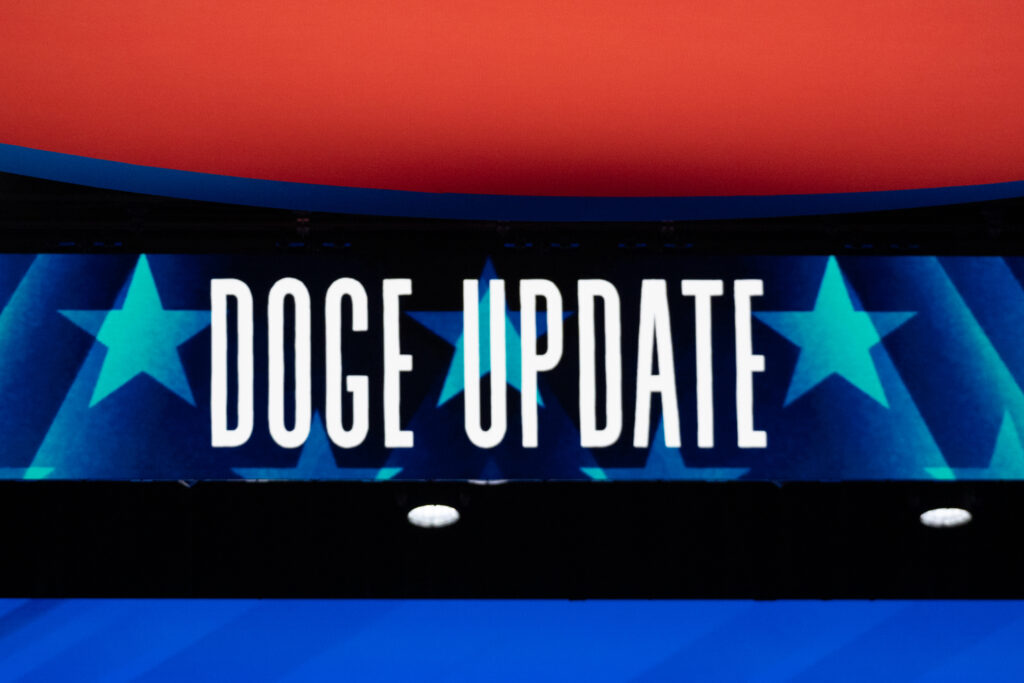
As DOGE continues to assail the government, media coverage tends to frame Musk’s role as chaotic and self-serving more than ideological. A recent analysis in CNN referred to his approach as “haphazard nihilism.” And it’s true that Musk doesn’t necessarily embrace everything about the worldview espoused by Project 2025 architects like Vought, though Musk did recently say he identifies as a “cultural Christian” on the podcast of climate crisis denier and right-wing influencer Jordan Peterson.
But Dochuk, the Notre Dame history professor, said that Silicon Valley increasingly sees itself as aligned with hard-right evangelical leaders on one front: a fervent desire to downsize the government.
“It’s always been a bit of a tension between the Libertarian and social conservative agendas,” Dochuk told DeSmog. “But this difference isn’t as great as students of American politics have long assumed. There has long been plenty of overlap — and not just overlap, but intersections — between these interests.”
Silicon Valley libertarians may represent a new flavor, he said, but they are part of the same general dynamic.
Ultimately, Musk’s deeply held ties to Project 2025, and the organizations in its orbit, show that his wrecking-ball approach was neither haphazard nor nihilistic — its aim was purposeful and ideological. He largely served to enact the playbook drawn up by the Heritage Foundation and others, with connections to those groups that go back years.
In a recent fundraising pitch, the Heritage Foundation made that link explicit.
“Our experts create policy solutions and plans that will cut government spending,” it wrote. “And when you activate your Heritage Foundation membership today, you will help The Heritage Foundation work with the Trump-Vance Administration to ensure the DOGE spending cuts succeed.”
As the White House looks forward to a post-Musk DOGE, it’s clear who has the power now: Vought and his allies in the executive branch, who originally dreamed up the playbook that DOGE has done so much to advance. On May 12, the Wall Street Journal reported that Vought would “inherit” the DOGE agenda — with other outlets speculating that he’ll be tasked with making the Musk cuts permanent.
In a May 14 interview with Fox News, Vought denied being DOGE’s heir apparent, at least in terms of his official title. But he made clear the work would continue:
“We intend to take the DOGE agenda and the cuts and the momentum and the initiative and turn those into permanent savings. That’s what we believe is our responsibility.”
In other words, it was always bigger then Musk.
“DOGE is at work. They’re not going away,” he added. “I talk to them every single day.”
DeSmog sent a request for comment to Musk via the press team at X, but had not received a response by press time. Vought and the Office of Management and Budget had not responded to a request for comment made through OMB’s press office. Requests for comment made to America First Legal, the Conservative Policy Institute, the DOGE House Caucus, and the Heritage Foundation went unanswered by press time.
Subscribe to our newsletter
Stay up to date with DeSmog news and alerts


